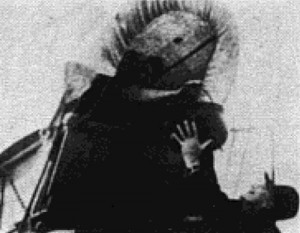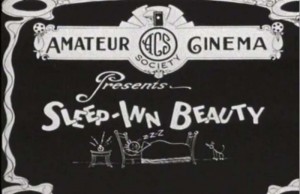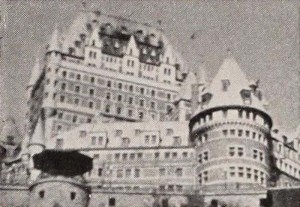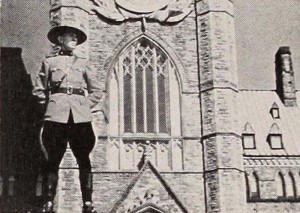
The film received the "Sound Award for the most effective use of sound, and the new MPD Documentary Film Award which is being given for the first time this year. The film might be described as a re-created or dramatized documentary and depicts the early life of the settlers who tilled the soil and made a living over a century ago. In the film we meet Will and Maggie McLeod who have just purchased a farm and are returning in their covered wagon from an auction sale where they have purchased several belongings for their new home. Will McLeod was a ship builder in Nova Scotia, but when that industry died down he decided to migrate westward. This film is their story and shows the struggles they encountered and depicts their way of life in those early days. Excellent photography and excellent editing, coupled with good pacing - all of which are typical Ruddell trademarks - blend well together to this top award film" PSA Journal, Sept. 1965, 50.
The film is also known as The Settlers: Early Pioneer Farmers of the Great Lakes Region.
"Shows Don and Phyllis Munday family travelling from Vancouver to Prince Rupert on the S.S. 'Cardena', including a long stop at Bella Coola, and climb up Mount Saugstad" British Columbia Archives.
"Filmed by John C. Jay, Jr., ACL, of Williams College, Skis Over Skoki was shown recently at the Eleventh Annual Show of Amateur Motion Pictures, sponsored by Duncan MacD. Little, ACL. Mr. Jay's film, which is 400 feet of 16mm. Kodachrome, accompanied by sound on disc, was made for the Canadian Pacific Railway and will be shown by them to major ski clubs throughout the country. The film outlines a short story of a girl who, having grown bored with the usual mountain trails, leaves her guide during one of the downhill runs and starts over treacherous territory alone. How she ends her journey and what happens en route are shown by Mr. Jay in some of his finest pictures of skiing, a field in which he is an expert. He has made several films of skiing in the past" Movie Makers, June, 1940, 279.

"SleepInn Beauty is a comedy situated around a bathing beauty contest based on a story adapted by Dorothea Mitchell. Filmed over two days North of Port Arthur near Mitchell's camp at Surprise Lake, Wally McComber (the "Goof" of A Race for Ties) played the leading man and Maye Flatt, the leading lady. Fred Cooper shared the photography duties with Lloyd Small and took a minor acting role. In addition, over sixty extras were bussed in from Port Arthur to take part. The film was never exhibited publicly although, considering Mitchell's efforts with A Race for Ties, it was most certainly shown privately." Ladylumberjack.ca
"Garden shots, including time lapse shots of flowers opening, and a 1962 parade in Sidney or Victoria" British Columbia Archives.
"The film contains twelve short vignettes that incorporate several cinematic techniques to comical effect." Library and Archives Canada.
"The unique wilderness of the Spatsizi Plateau, and the area's flora, fauna and scenery, as observed by guide-outfitter Tommy Walker. The film points out the negative impact of recent development in the area, and emphasizes the importance of preserving the Spatsizi. Mountain sheep, Stone sheep, Osborn caribou, moose, eagles, beaver, marmots, and many other wildlife species are shown" British Columbia Archives.
This film was produced at some time between 1956 and 1970.

"When you ramble about on a cinematic tour of old Quebec in Carl Nerish's St. Lawrence Sketches, you feel that here at last is a new and different theme for the travel film. The Old World atmosphere of that delightful city is shown with loving sympathy. One of the outstanding points is a clever and human continuity device employed to carry the story along during a tour of the city in a horse drawn carriage. Spoken titles are used with striking closeups of the quaint cab driver who is pointing out the sights to Mr. Nerish and his audience. By studying each shot of the driver, Mr. Nerish was able not only to present a varied series of shots of him, but also to show enough background material to add a good deal to the scenes presented in the regular course of the film. Equally effective are the shots of people in the market place, where a telephoto enables Mr. Nerish to get unposed views. A carefully chosen, but somewhat detailed, musical background was played throughout the film, and it served in no small measure to lend atmosphere to the production. Special credit is due the filmer for his precisely executed titles. Such painstaking work as that involved in centering and lining up movable title letters is seldom seen." Movie Makers, Dec. 1939, 632.
This film was produced at some time in the 1950s.

"Sweeping in its conception, stirring in its execution, Then Came the King is a vivid and beautiful epic of honest patriotism. In it, Earl L. Clark has examined the Western way of life, and he has found it good. With elaborate but never exhausting detail, the film traces the history of Canada — and more briefly her American neighbor — from 1800 to the present day. Then, in a world challenged by war and a Canada accused of waning fealty to the Empire, Then Came the King pictures with a magnificent climax the deep and unfaltering affection in which a loyal people hold their rulers. People of all classes and occupations are shown saluting Their Majesties. Sensitively planned and superbly titled, the film very definitely has something to say — and says it with distinction. Viewpoint after viewpoint strikes sensuously on the eye as exactly right for the effect desired. Sequence after sequence marches down the screen with the brave and stirring rhythms of epic poetry. On a few occasions, Mr. Clark's striking imagination has outstripped his straining technical skill, but. from his first frame to his last, the work is stamped unerringly with a fresh and genuine creative spirit." Movie Makers, Dec. 1939, 632.
Total Pages: 12